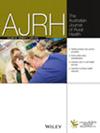This article explores the crucial role of ‘place’ as an ecological, social and cultural determinant of health and well-being, with a focus on the benefits and challenges of living rurally and remotely in Australia.
The health system, including health promotion, can contribute actively to creating supportive environments and places that foster health and well-being among individuals residing in rural and remote locations. For First Nations peoples, living on Country, and caring for Country and its people, are core to Indigenous worldviews, and the promotion of Aboriginal and Torres Strait Islander health and well-being. Their forced removal from ancestral lands has been catastrophic. For all people, living in rural and remote areas can deliver an abundance of the elements that contribute to a ‘liveable’ community, including access to fresh air, green and blue space, agricultural employment, tight-knit communities, a sense of belonging and identity, and social capital. However, living remotely also can limit access to employment opportunities, clean water, affordable food, reliable transport, social infrastructure, social networks and preventive health services. ‘Place’ is a critical enabler of maintaining a healthy life. However, current trends have led to a reduction in local services and resources, and increased exposure to the impacts of climate change.
This commentary suggests ideas and strategies through which people in rural and remote locations can strengthen the liveability, resilience and identity of their communities, and regain access to essential health care and health promotion services and resources.
Recommended strategies include online access to education, employment and telehealth; flexible provision of social infrastructure; and meaningful and responsive university-health service partnerships.


